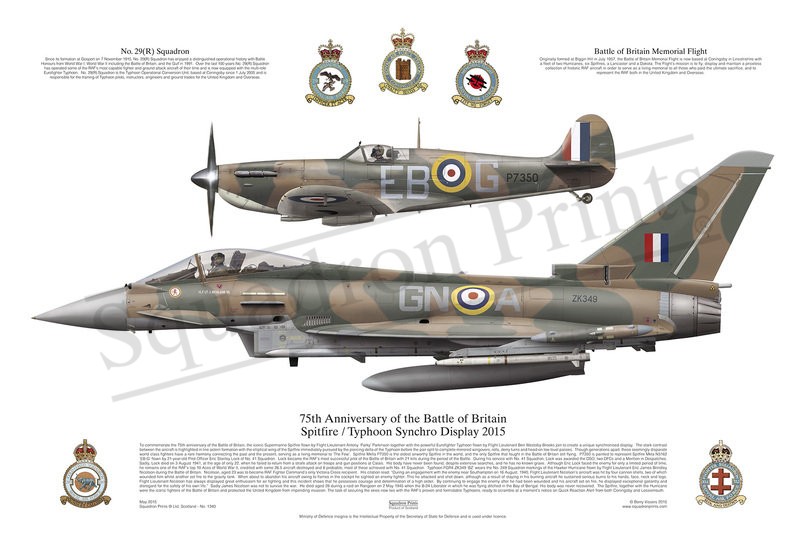#1340 2015 Spitfire and Typhoon Display Print

Description
Squadron Prints Lithograph No. 1340 - 75th Anniversary of the Battle of Britain, Spitfire / Typhoon Synchro Display 2015. To commemorate the 75th anniversary of the Battle of Britain, the iconic Supermarine Spitfire flown by Flight Lieutenant Antony ‘Parky’ Parkinson together with the powerful Eurofighter Typhoon flown by Flight Lieutenant Ben Westoby-Brooks join to create a unique synchronised display. The stark contrast between the aircraft is highlighted in line astern formation with the elliptical wing of the Spitfire immediately pursued by the piercing delta of the Typhoon before the pair split to complete mirrored wingovers, rolls, derry turns and head-on low level passes. Though generations apart, these seemingly disparate world class fighters have a rare harmony connecting the past and the present, serving as a living memorial to ‘The Few’. Spitfire MkIIa P7350 is the oldest airworthy Spitfire in the world, and the only Spitfire that fought in the Battle of Britain still flying. P7350 is painted to represent Spitfire MkIa N3162 ‘EB-G’ flown by 21-year-old Pilot Officer Eric Stanley Lock of No. 41 Squadron. Lock became the RAF’s most successful pilot of the Battle of Britain with 21 kills during the period of the Battle. During his service with No. 41 Squadron, Lock was awarded the DSO, two DFCs and a Mention in Despatches. Sadly, Lock died on 3 August 1941, at the age of only 22, when he failed to return from a strafe attack on troops and gun positions at Calais. His body have never been found, despite extensive searches, and he has no known grave. Although Eric Lock faced the enemy for only a limited period of time, he remains one of the RAF’s top 10 Aces of World War II, credited with some 26.5 aircraft destroyed and 8 probable, most of these achieved with No. 41 Squadron. Typhoon FGR4 ZK349 ‘BZ’ wears the No. 249 Squadron markings of the Hawker Hurricane flown by Flight Lieutenant Eric James Brindley Nicolson during the Battle of Britain. Nicolson, aged 23 was to become RAF Fighter Command’s only Victoria Cross recipient. His citation read: “During an engagement with the enemy near Southampton on 16 August, 1940, Flight Lieutenant Nicolson’s aircraft was hit by four cannon shells, two of which wounded him whilst another set fire to the gravity tank. When about to abandon his aircraft owing to flames in the cockpit he sighted an enemy fighter. This he attacked and shot down, although as a result of staying in his burning aircraft he sustained serious burns to his hands, face, neck and legs. Flight Lieutenant Nicolson has always displayed great enthusiasm for air fighting and this incident shows that he possesses courage and determination of a high order. By continuing to engage the enemy after he had been wounded and his aircraft set on fire, he displayed exceptional gallantry and disregard for the safety of his own life.” Sadly James Nicolson was not to survive the war. He died aged 28 during a raid on Rangoon on 2 May 1945 when the B-24 Liberator in which he was flying ditched in the Bay of Bengal. His body was never recovered. The Spitfire, together with the Hurricane were the iconic fighters of the Battle of Britain and protected the United Kingdom from impending invasion. The task of securing the skies now lies with the RAF’s proven and formidable Typhoons, ready to scramble at a moment’s notice on Quick Reaction Alert from both Coningsby and Lossiemouth.
You may also like
-
43 Squadron Triple Tornado F3 Phantom Hunter
XV579 'R'; ZE887 'GF'; WT587 'C'43 SqnRAF Leuchars -
Typhoon, Poseidon
ZK368; ZP801; ZK321; ZK3361 Sqn; 2 Sqn; 120 Sqn; 51 Sqn Regt; 2622 SqnRAF Lossiemouth -
"Union of South Africa" Gresley A4 Class Train
60009; Gresley 4-6-2 A4 Class TrainUnion of South Africa
